Porokiya bhabe brojo modhho baas
Prembhabe paiya ami hoilam daas
Mori re mohabhab loiya ami bandha dinu mon
Krishnoshokti janiya deho korilam shomorpon
(My heart bleeds with the clandestine trappings of illicit love
Enslaved by the yearnings of intimacy
Torn within, my acquiescent mind gives in
And breaches the walls of my vulnerable body too)[1]
Folk theatre in Bengal has a rich legacy and it continues to blend components of music and drama to create a performative space that attracts large audiences in some places, especially the districts of Bengal. It is largely tied to a sense of place and relates to a sense of community;[2] it is also a potent tool to disseminate the local knowledge of the community and has a notable role in preserving the traditional ways of delivering a social message using the language of common people.[3]
Khon is a traditional satirical folk drama of the Rajbanshi community of North Bengal, also known as Deshiya Poliya, who mainly reside in different blocks of Dakshin Dinajpur and Uttar Dinajpur ranging from Kushmandi, Banshihari to Gangarampur and Harirampur. Khon can be found in greater Dinajpur and northern parts of Malda district of West Bengal. The musical folk drama is interlaced with elements of theatre, song and dance. It is a community performance form that has often been considered ‘low culture’ in the mainstream discourse of theatre.[4]
To examine the origin of khon, it is quite important to relate its foundation to the history of performers who mostly belong to the Rajbanshi community of Dinajpur district.[5] At the time of Partition of India, Dinajpur district got divided into West Dinajpur (India) and East Dinajpur (Bangladesh), Uttar (North) and Dakshin (South) Dinajpur were carved out by the division of erstwhile West Dinajpur on April 1, 1992.[6] Khon is an important part of Dinajpur’s rich cultural heritage which is still thriving despite relentless pressures of commercialisation of theatre.
The history of the word khon has been interpreted by many people, in multiple ways, and there are varying accounts of khon’s genesis, according to scholars who have worked on the origin and the history of khon. Dr Samit Saha, who is a professor at the Bengali department in Balurghat College, states that the genesis of this dramatic form dates back to the seventeenth century and contains the reconstructed stories of the great Hindu epics, Ramayana and Mahabharata. He is also of the opinion that khon is a representative form of the cultural inheritance and tradition of Dakshin Dinajpur. On the other hand, Pijush Kanti Deb, the editor of the local newspaper Balurghat Barta, presents a narrative that delves into the relationship between the Rajbanshi community and the emergence of khon dating back to almost 400 years. In his words, the Rajbanshi community belonged to the agrarian society and lived along the cultivable areas on the banks of rivers; khon was their primary source of entertainment in an age when there was no electricity, and it predated jatra (a popular folk theatre form in Bengal). The local zamindars of undivided Dinajpur used to act as benefactors of these khon performances and performers.
Debesh Goswami, a theorist who has worked on the folk culture of Dakshin Dinajpur, while tracing the history of khon, states that the Rajbanshi community owes their anthropological origin to the Austro-Asiatic mongoloid tribes from Cambodia, Thailand, and Vietnam who had migrated to India to disseminate Buddhism, and settled along the river banks of Punarbhaba, Atrayee, Kulik, etc. A potent tool for the dissemination of Buddhism was khon pala gaan(roughly, songs of moments). During the period of revival of Hinduism, stories from religious texts like Ramayana, Mahabharata, and the Puranas gained popularity and were replicated through performances. They found prominence in khon as well, especially in the shastori variant of khon. He further adds that the concept of baudiya (consensual leader in the group) is basically an extension of the tradition of gurubaad (the tradition of knowledge being imparted from a guru to a disciple), which is a practice that became prevalent among the Vaishnavas of Bengal following the movement led by Chaitanya Mahaprabhu. This movement enabled the emergence of a more secular brand of Hinduism that drastically influenced the folk culture in North Bengal; following the Vaishnava movement, even among the khon groups, the concept of a guru/ teacher and a leader merged into one. According to Goswami, khon is a depiction of the life of every rural household, based on the farming practices of the agricultural labourers as well as on the theme of religiosity.[7]
Essentially, the word khon, in Rajbanshi, comes from khonik (moment). Goswami in his essay states that the word khon owes its origin to khondo (an episode or a part of the whole). Khon is a collection of the real-life incidents of the agricultural labourers of the Rajbanshi community. It can be performed either as a means of entertainment or as a mark of commemoration during festivities, religious or otherwise, which includes enacting episodes from ancient texts (Ramayana, Mahabharata, Puranas) and celebrating the onset of harvesting season.
According to famous khon artist Khushi Sarkar, during the harvesting season in the month of Agrahayana (ninth month of Hindu calendar, coinciding with late November and December), these performers used to perform khon pala gaan both within their own villages as well as in their adjacent villages.[8] In khon performances, khon pala gaan (songs) plays a very important role in contributing to the melody. Sourav Roy, a khon artist of the Ushabhanu Natyo Dol, a theatre group in Kushmandi block, describes the flow of any khon performance as ‘Joto shonglaap, toto gaan, tar naam khon pala gaan’ (As many dialogues as there are songs, this is khon pala gaan).
Types of Khon: Khissa and Shastori
There are two categories of khon, khissa khon and shastori khon. It is important to note the transition of khon from shastori khon, a ritualistic performance based on Puranas to khissa khon, a non-ritualistic performance that deals with diverse social issues that plague society.
Khissa khon highlights the local stories that challenge the existing societal norms. Khon mirrors the society of Dinajpur and its woes; with time, as the societal customs and economic conditions of khon started changing, the themes also changed to depict love and its many manifestations. The subject of the play centres around the stories of mundane life and it relates to social and familial accounts of illicit affairs and clandestine love. The precursory evolution of khon as an oral form of storytelling goes back to beggars and house-helps acting as story conveyors of neighbourhood scandals involving a man and a woman. All the khon performances that have the suffix ‘shori’ are the stories of women involved in scandalous affairs with other men; some popular examples are Shisoshori, Brahmoshori,Dhakoshori, Antoshori, etc. Few notable khissa khon performances include Mayabondoki, Sapuria Murder, Halua Haluani, Cycleshori, Muchila Murder, Haji Boro Paaji, and Sadhu Boro Shoitan, based on real life incidents. Mayabondoki portrays the heart-breaking reality of the life of the underprivileged labourers and tells the story of a debt-ridden person who is forced to pawn his daughter; another performance, Toophanshori deals with an affair between a local woman in the community and an Afghan dry fruit seller. Contemporary khon performances include Tebhaga Khon by Khushi Sarkar that depicts the class struggle of peasants against extortion by oppressive zamindars; on the other hand, the theme of Minatishori Police Murder by Madhai Mohanta is women trafficking. Khissa khon, therefore, is a sort of historical enactment of the past and present. The tonality of khissa khon encircles sarcasm, and the themes have shifted from mythological tales to social injustices. This theatrical performance often includes witty dialogues punctuated with sexual connotations to grab the attention of the audience without diminishing the effectiveness of the message.[9] In this way, it is a non-ritualistic performance and stands in contrast to the other folk dramas such as Ram Banabas Pala, Monosha Mongol, Kojagori Lakkhi which fall within the purview of ritualistic performance.
Less prevalent now, shastori khon refers to rituals and episodes from religious texts; it deals with the Puranas and other religious texts. The pivotal theme, however, is always love. It forms an interesting intersectional point between divine love and worldly love in human relationships. Although shastori khon caters to enactment of certain episodes from religious texts, it is predominantly secular in nature, transcending the boundaries of religion and involving people from different religions.
Some of the famous shastori khon performances are about the social affairs in the lives of religious deities like Chandi, Monosha, and Durga. Prominent among the shastori khon performances are Noyonshori, Bhrahmoshori, Boshtom Baudiya; the main theme of Brahmoshori is surrendering oneself to extramarital love, while Noyonshori is about following the path of the guru. Owing to the social composition of the khon performers who are mainly agricultural labourers in an agrarian society, some elements of this folk drama were initially associated with the religious practices found in these communities dedicated to increasing the fertility of land. The Rajbanshis celebrated the onset of the harvest season, by indulging in rhythmic verses or songs interspersed with dialogues. The performances always start at night, two to three hours prior to midnight, and continue into the early hours of dawn. What is interesting to note here is that the performers start with a reverential form of worship or dedication, not just in shastori khon but in certain places of the khissa khon as well, invoking Hindu divinities like Brahma, Vishnu, Shiva/ Maheswar, Kali, Saraswati and also the names of Muslim pirs, mazars, dargahs, etc, signifying the secular ethos of khon. After the invocation, the play starts, and the introduction mandatorily begins with a song known as the bondona (hymn).
Khon as a Performance Tradition
Khon performances are fictionalised/dramatised accounts of real-life incidents, especially those involving illicit love affairs, clandestine love, scandalous events, and criminal cases. Khon presents rural life as a collage of such happenings and they together form the palas (episodes) of khon told in a comic-satirical style. Most of the songs are composed during the leisure time of the hardworking agricultural Rajbanshi people to channelise their inherent musical skills in striking a chord with everything that is present in nature and their lives.[10]
Artist Sourav Roy states that khon is an oral tradition and is dominated by the use of dialogues in the local dialect of the Rajbanshi community which is a mixture of Kamrupi, Varendri, and Bengali.[11] The artists do not have written scripts for their performances; they frame the basic structure of the play around a story inspired by daily events, while most of the dialogues are articulated at the spur of the moment. In an interview, Jaga Baishyo, a leading khon artist, laments over the gradual change in overall form and modalities of khon:
I think the performance of khon is slowly changing its structure and form to appeal to a larger mass and is reaching out to people outside the regional districts. We have remained outside the purview of mainstream/ formal education and thus, in the original form of khon, we see that the dialogues are orally transmitted from one generation to the next. In the last 50 to 60 years, the successors of the performers have started writing down certain parts of their performances.[12]
These performances are practised in the Kamrupi dialect which is popular among the Rajbanshi community. Phanindranath Basak, another leading khon artist of Ushabhanu khon group, states that in the contemporary times, the language of the performance has also undergone a significant change where the Kamrupi dialect is punctuated with mainstream Bengali words.
Khon performances usually take place in circular open spaces surrounded by an audience. In the circular area, there is an open pathway which acts as both entry and exit point for the performers. It is starkly different from mainstream theatrical performances which have a permanent immovable stage; khon is performed in front of the house of theartists or in an open space in the community where the performers clean the place before performing. While the concept of stage was not present in the age-old performances of khon, with governmental intervention, the idea of a stage is gaining popularity among the performers. The performance space of khon involves three circles, the innermost circle is called dohar from where the performers play musical instruments. (Fig. 1) The middle circle is where the performers act out their dialogues and the outer circle is where the audience sits, surrounding these performers. This circular shape of the performing space symbolises a form of socialist community living where people do not have any form of hierarchy, they sit together, and everybody has the same access to the performance space which may or may not be debosthan (where the gods/ goddesses are worshipped).
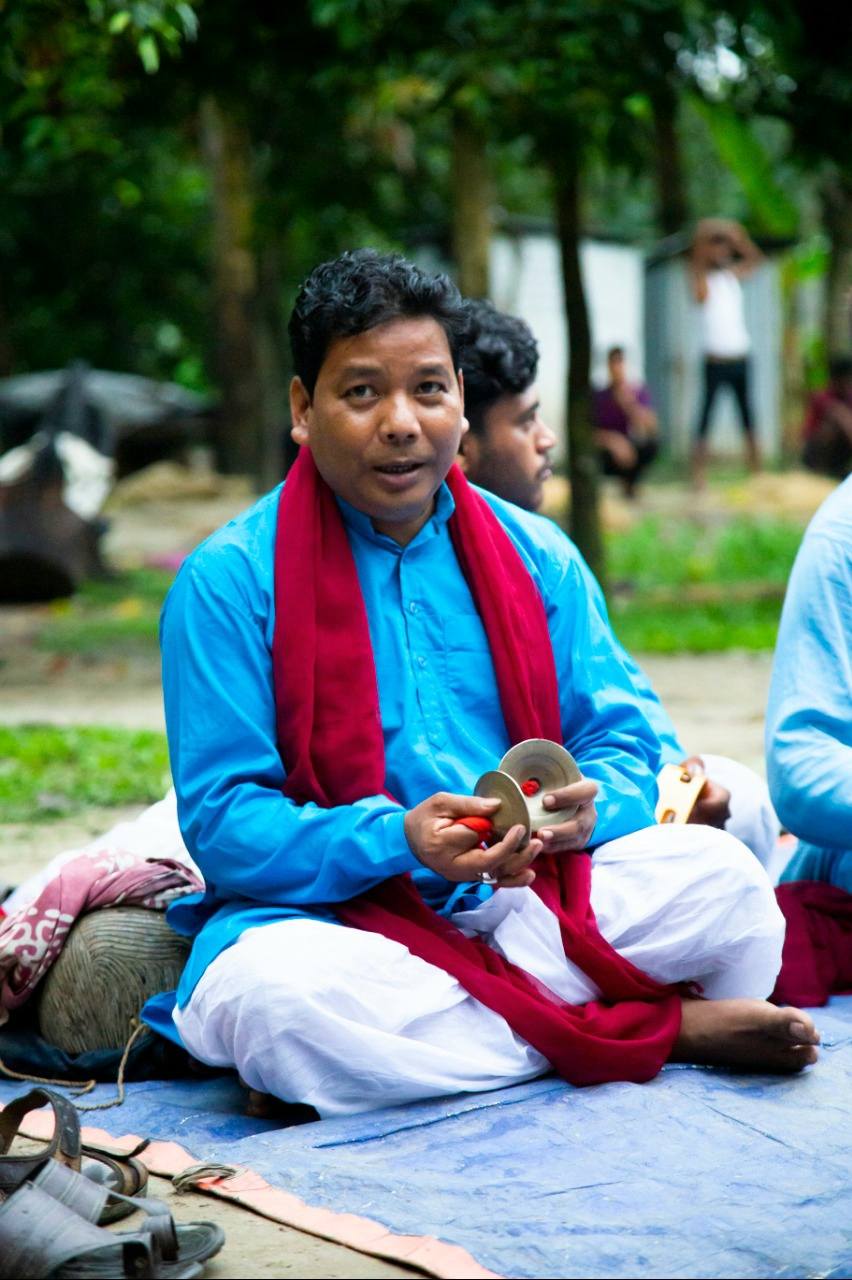
A khon performance is entirely a community-based performance where the artists collect chanda (donation from the community) and procure the essential performing tools and props (lipstick, false hair, face powder, costume, etc.). Traditionally in khon performances, one single prop like a bamboo stick was used for different purposes but with the changing times, the artists have started making different kinds of props to cater to the visual pleasure of the audience. The artists primarily used moshal (fire torch) for lights for the performance. Saral Sarkar, an artist from Ushabhanu Natyo Dol, also mentions the use of hajak (a kerosene lamp) lamp as lights for performances—petromax and hajak lanterns are widely used in the folk theatre of Bengal.
Traditionally, khon was performed by the male artists and they used to cross-dress as women characters. Some of the male actors who are quite popular for donning the female roles are Saral Sarkar and Bhabesh Basak from Ushaharan, and Madhav Sarkar from Mohisbathan. (Fig. 2) (Fig. 3) However, over time, women have also found equal representation in khon performances. The costumes of the women khon artists mostly include saree and blouse, and they do their own make-up using vermillion powder, sandalwood powder, lipstick, and kajal; the male artists mostly wear panjabi, dhoti, lungi, and a gamcha (light cotton towel). At times, khon performances are accompanied by dance moves to lend a dramatic expression to the plot of the play. In traditional khon, the use of wooden masks was not prevalent, but the new age khon performances are adapting to the changes in the society and using mukha (G.I.-tagged wooden masks of Kushmandi block in Dakshin Dinajpur district) to make the act more vibrant and colourful.[13] (Fig. 4)
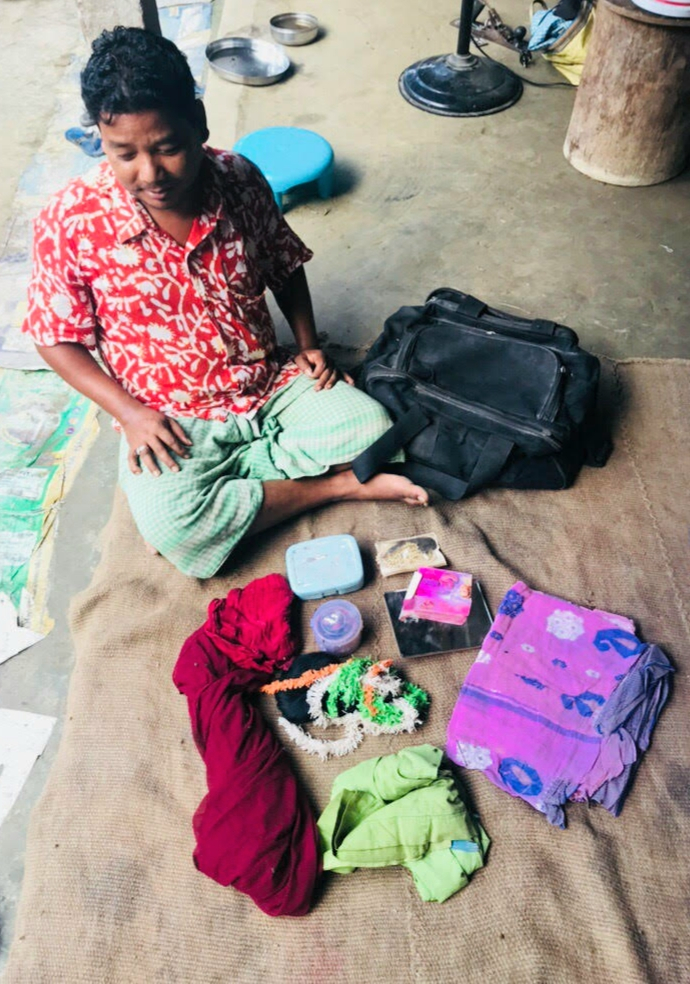
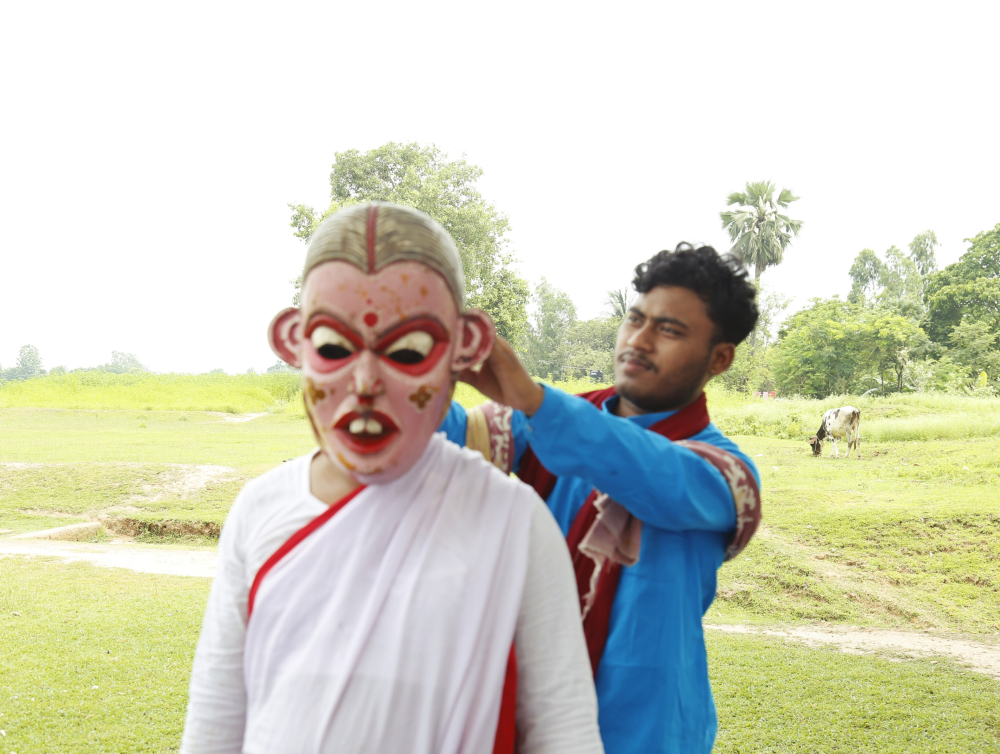
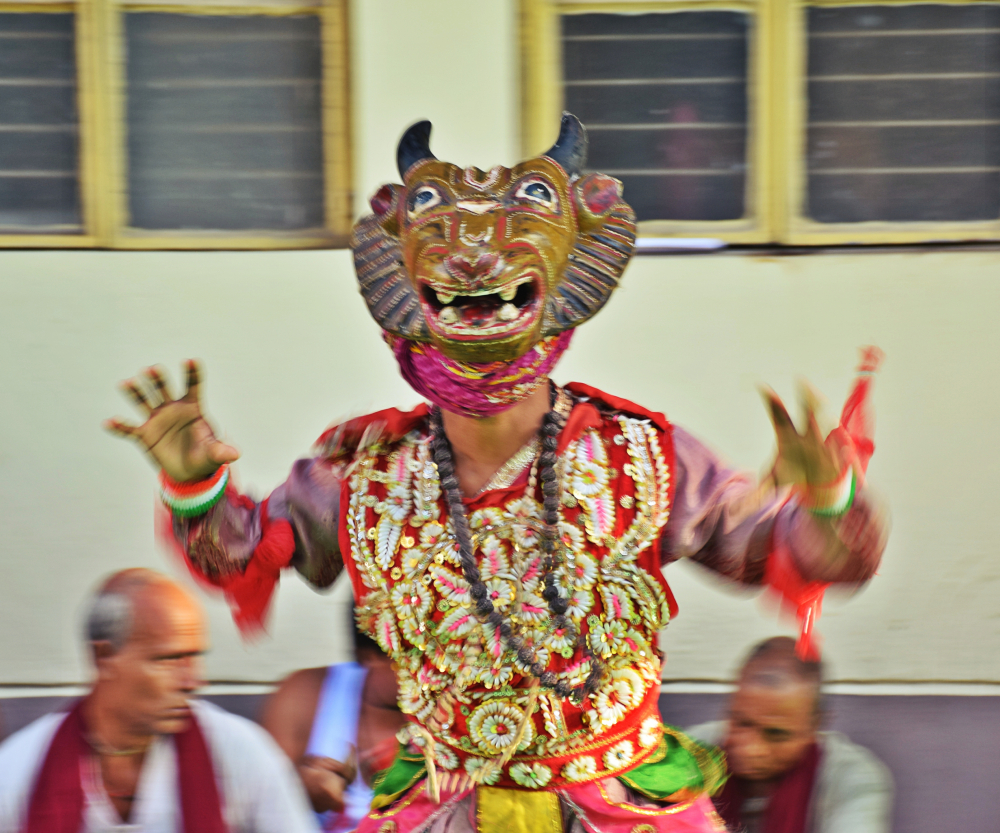
In the khon team, there is a gayen (the chief song maker and singer), and there is a group of people who play the musical instruments—dhol/ dhak, shehnai, tabla, ektara (a string instrument), kartal, khol (a type of drum), madal (a hand drum), which have now been replaced by relatively modern instruments like the harmonium and flute. Among the actors, the most interesting one is perhaps the doyari (a comic character) similar to the Shakespearean clown; what really stands out about the doyari is the fact that apart from adding humour in the performance, he also repeats some of the lines sung by the gayen. The doyari also plays an important role in delivering a social message in a comical way and acts as an interface between the artists and the audience.
Khon groups include anywhere between 14 to 20 members and are led by the leader of the group known as baudiya, boshtom baudiya, pichol baudiya, or janak. There are several khon performance groups that are found in the different districts of Dakshin Dinajpur, Uttar Dinajpur, and Malda, notable among them are Kushmandi Gramin Lokosonskriti o Bhasha Unnoyon Shongshtha led by Khushi Sarkar; Ushabhanu Lokonrityo Natyo Shongstha led by Sourav Roy;Mohisbathan Naarikolyan Samiti led by the first woman khon artist, Akulbala Sarkar (Fig. 5); Gram Unnoyon Lokoshilpi Sangha led by Madhav Sarkar; Nobo Lokmoncho Sanskritik Dol led by Biren Basak; Ayna Mohol led by Noresh Roy;Shorola Geeti Natyoshongshtha led by Dwaityochandra Sarkar and Dibanishi Khon Dol led by Noren Sarkar in Kushmandi; and Radhagobindo Loknatyo Khon Shomproday led by Dulu Debsharma, Phulot Loknatyo Khon Sampraday led by Subol Deshi in Harirampur. Prominent khon artists include Sourav Roy, Jaga Baishya, Phanindranath Basak, Bhabesh Basak, Saral Sarkar, Suresh Sarkar, Sanatan Sarkar, Shibu Sarkar, Kamala Baishya (Fig. 6), Mamata Baishya, Subhash Sarkar, Anil Sarkar, Dwijen Sarkar, Akulbala Sarkar, Chitra Sarkar, Madhav Sarkar, Ramani Kanta Sarkar, and Geeta Sarkar.
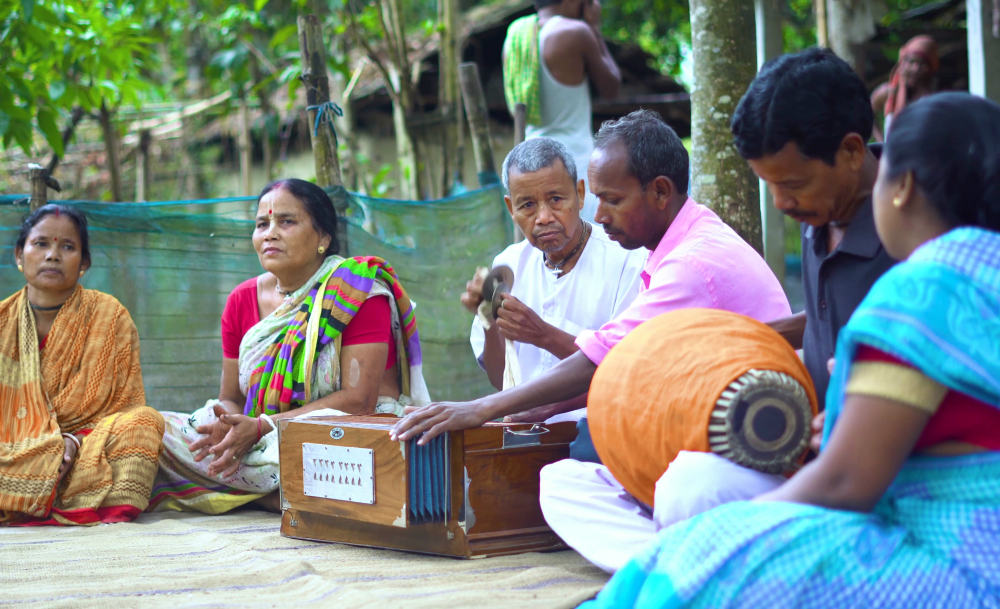
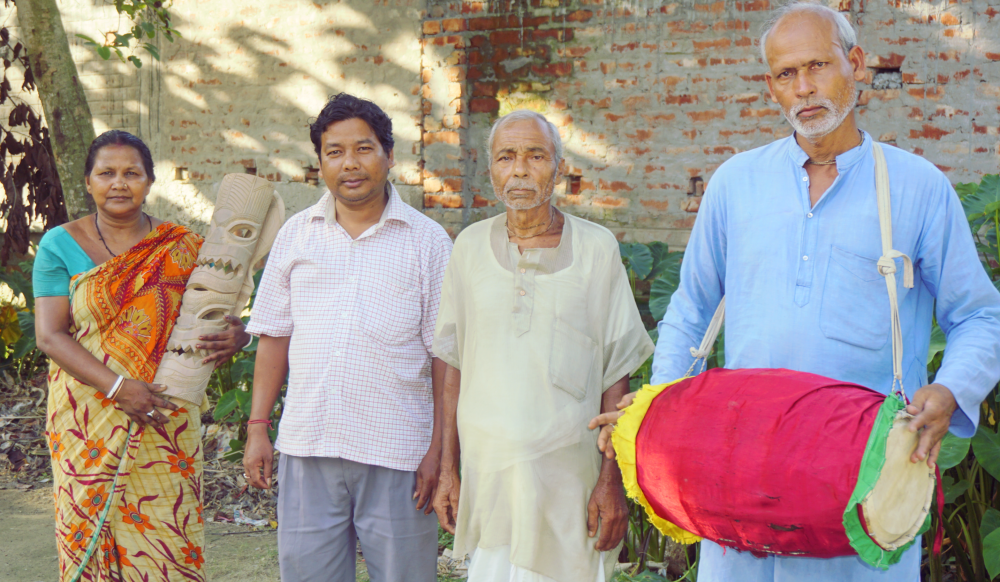
Women in Khon Performances
Performing in khon was always considered to be a taboo for women in a male-dominated society as it required them to move beyond the private sphere of household and engage with other artists in the public sphere.
Akulbala Sarkar, as the rebel woman artist, became a torchbearer for the movement, and unshackled herself from this social stigma. Initially, her involvement in khon led to her ostracisation by her family and community members. She first performed in the play named Hajakshori which was led by Bandaru Sarkar. Gradually, she started encouraging the girls of her community to take part in khon performances and later went on to form a khon group with all-women performers including her daughter, Geeta Sarkar. She has performed Halua Haluani twice in Delhi, Kolkata, Jalpaiguri, Darjeeling and Siliguri. (Fig. 7) The women artists who perform in her group are Chitra Sarkar, Kemota Sarkar, Joshodha Sarkar, Panchami Sarkar, and Aheli Sarkar. (Fig. 8) One of their most prominent plays is Durga Boli which they perform as a part of Kojagori festival before the onset of Durga Puja. Akulbala Sarkar says:
Now I have the liberty to convince them that taking part in khon is no longer a taboo. I was the one who was ostracised back in my days, but now the society is far more accepting and at times encouraging too. It feels good to be some sort of a torchbearer for women-led khon performers. I used to get paid four annas for every performance but now, performers are getting government-aided pension, so you can say that the scenario has changed in our favour over the years. My husband is the chief composer while I sing and act along with other members. The audience reaction has also changed over time. [14]


She has performed in Pumpingshori, Buloshori, Sapuria Murder, and Police Murder. There are other khon groups with female khon artists like Kamala Baishya who is a prominent actor in Ushabhanu Natyo Dol in Kushmandi. (Fig. 9)

Government Intervention
The Department of Information and Cultural Affairs of West Bengal offers its flagship welfare scheme, Lok Prasar Prakalpa, which is directed at the economic upliftment of folk artists and the revival of the ancient folk culture of Bengal. It helps folk artists through its provision of financial stability and gives their work visibility and recognition. The state government also offers INR 100 in the form of bhata (monetary compensation) to recognise their work as registered folk artists.
The khon artists are involved in awareness and publicity campaigns for government various schemes. These schemes also play an important role in enhancing the popularity of khon outside the districts of origin, across Bengal and even beyond. In addition, the schemes aim at making the messages of the government more accessible among the rural populace. Some of the social issues that are publicised by government schemes using khon as a medium of expression include prevention of child marriage, awareness about superstitions as well as the prevention of vector-borne diseases, especially dengue. (Fig. 10) Khon has also been used to raise awareness about different schemes like Mission Nirmal Bangla (sanitation programme), Utkarsh Bangla (technical education to unemployed youth), and during election related campaigns and awareness programmes. (Fig. 11) The accessibility to, and acceptance of, government schemes is ensured through khon performances. Despite changes in the basic structure of khon, the form has not lost its original flavour because the government officials are providing them the platform to showcase their performances in places outside their district, both within the state and across the country. Just like the Baul festival in Birbhum district, for the first time, an exclusive festival for khon was held on February 21 and February 22, 2018, in Dakshin Dinajpur, which was inaugurated by the chief minister of West Bengal, Mamata Banerjee. It is noteworthy to mention that February 21 happens to be International Mother Language Day, a nod to the indigenous language of the Rajbanshi community. More than 200 khon artists from different districts participated in the festival.[15]
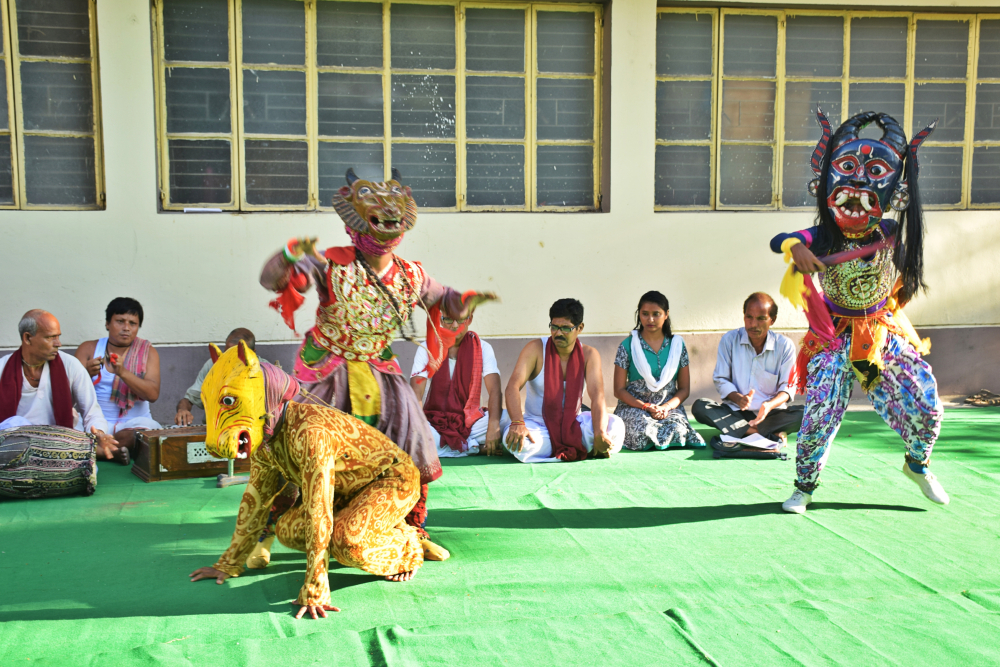

Khon is socially relevant owing to its ability to inform others and induce a sense of collective living, and it acts as moral compass of the Rajbanshi community. It gives an identity to Dakshin Dinajpur, a true representative art form of the place’s cultural inheritance and tradition.
Notes
[1] Goswami, ‘Lok Natok Khon,’ 148–155.
[2] Dey, ‘Folk Culture of West Bengal,’ 1–3.
[4] Bhattacharya, ‘Lok Shilpo,’ 124–142.
[6] Roy, ‘Paschim Dinajpur Jelar Tofoshili Jaati Shomuher Porichoy: Shamajik Orthonaitik Sanskritik Prekhapot,’ 23–46.
[7] Debesh Goswami, ‘Lok Natok Khon,’ 148–155.
[8] Ibid.
[9] Majumder, ‘Paschim Dinajpurer Lokshomaaj o Sanskriti—Ekti Roopkatha,’ 78–85.
[10] Chowdhury, ‘Paschim Dinajpurer Loknatyo: Ekti Samiksha,’ 434–445.
[12] Jaga Baishyo, in conversation with the author.
[13] Phanindranath Basak, in conversation with the author.
[14] Akulbala Sarkar, in conversation with the author.
[15] District Information and Cultural officer of Dakshin Dinajpur, Santanu Chakraborty, in conversation with the author.
Bibliography
Chowdhury, Dulal, and Pallab Sengupta. Lok Sanskriti Biswa Kosh. Kolkata: Pustak Bipani, 2004.
Chowdhury, Dulal. ‘Paschim Dinajpurer Loknatyo: Ekti Samiksha.’ In Paschim Dinajpur Zilla Sankhya ‘Madhuparni’, edited by Ajitesh Bhattacharya, 434–445. Kolkata: Lipi Mudran, 1992.
Das, Abhik, dir. Khon Khonjar Pala. 2017. Accessed August 10, 2020. https://www.youtube.com/watch?v=swjePUVidhI.
Dey, Falguni. ‘Folk Culture of West Bengal.’ Journal of Institute of Landscape Ecology and Ekistics, no.1 (2012): 1–3.
Goswami, Debesh, ‘Lok Natok Khon.’ In Dakshin Dinajpurer Lok Sanskriti, edited by Ripan Sarkar, 148–155. Kolkata: Ghosh Publishing Corner, 2017.
Ghosh, Samit. ‘Lok Natok.’ In Dakshin Dinajpurer Sanskritik Aitijhya o Itihas: History and Culture of Dakshin Dinajpur, 320–332. Kolkata: Adhir Chandra Pal, Amar Bharati, 2014.
Kamat, Payal. ‘Short Essay on Folk Media.’ PreserveArticles.com. Accessed October 13, 2019. http://www.preservearticles.com/short-essays/short-essay-on-folk-media/18860
———. ‘Short Essay on the Impact of Folk Media,’ PreserveArticles.com. Accessed October 14, 2019. http://www.preservearticles.com/short-essays/short-essay-on-the-impact-of-folk-media/18855
Majumder, Sishir. ‘Paschim Dinajpurer Lokshomaaj o Sanskriti—Ekti Roopkatha.’ In Paschim Dinajpur Zilla Sankhya ‘Madhuparni’, edited by Ajitesh Bhattacharya, 78–85. Kolkata: Lipi Mudran, 1992.
Roy, Dhananjoy. ‘Paschim Dinajpur Jelar Tofoshili Jaati Shomuher Porichoy: Shamajik Orthonaitik Sanskritik Prekhapot.’ In Paschim Dinajpur Zilla Sankhya ‘Madhuparni’, edited by Ajitesh Bhattacharya, 23–46. Kolkata: Lipi Mudran, 1992.
